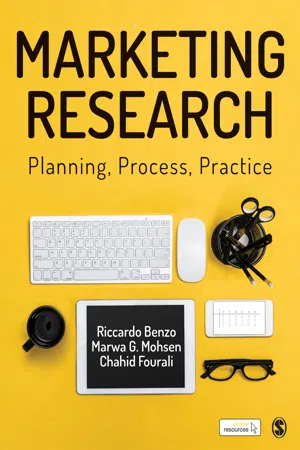
Marketing Research
Planning, Process, Practice
- 432 pages
- English
- ePUB (mobile friendly)
- Available on iOS & Android
About This Book
Marketing Research outlines the key principles and skills involved at each step of the marketing research process, providing readers with targeted, practical solutions to a range of issues and equipping them with the tools they need to overcome the common pitfalls of designing research projects. The chapters are arranged into core sections which progress systematically through the marketing research process, starting with designing and setting up research, to undertaking qualitative and quantitative research, and finally, summarizing and reporting research. To aid students in their research project, each chapter features a collection of learning features, such as:
- Case studies and international real-world examples
- Ethics boxes – Highlighting ethical implications in research projects
- Advanced boxes – Signaling more challenging topics students can return to after they have mastered the basics
- Activity boxes – Encouraging students to understand how what they have learned applies to their own experiences
The book is complemented by a range of online resources, including PowerPoint slides, multiple choice questions, free online exercise links, and discussion guides for Case Study & Additional Reading sections. Suitable reading for students who are undertaking a marketing research project.
Frequently asked questions
Information
Part I Setting Up Marketing Research
Chapter 1 Introduction: Adding Value with Marketing Research
Learning Objectives
- To define marketing research and its key dimensions
- To appreciate different perspectives in marketing research and their significance
- To discuss principles of and practices in marketing research
- To highlight key skills and capabilities for marketing research practitioners
Key Concepts
- Complexity and its impact on organisations
- What marketing research is
- Basic and applied marketing research
- Historical perspectives and the significance of marketing research
- Technology in marketing research: scope and application
- Creating value with marketing research
- Attitude, confidence and skills for learners
- Careers in marketing research
Introduction
Complexity: Breaking Down Research into Manageable Bites
- identifying issues (before they become problems)
- solving problems (together with their causes)
- understanding phenomena (about the world around us)
- taking advantage of opportunities
- fending off threats.
Understanding World Issues
Table of contents
- Cover
- Half Title
- Publisher Note
- Title Page
- Copyright Page
- Acknowledgements
- Table of Contents
- Extended Table of Contents
- About the Authors
- Online Resources
- Part I Setting Up Marketing Research
- Chapter 1 Introduction: Adding Value with Marketing Research
- Chapter 2 Identifying Marketing-Related (Business) Issues
- Chapter 3 Secondary Research: Facts and Theory
- Part II Planning Marketing Research
- Chapter 4 Conceptualising Research: From Secondary to Primary Research
- Chapter 5 Marketing Research Designs
- Chapter 6 Sampling
- Part III Qualitative Research in Marketing
- Chapter 7 Qualitative Research Methods: Elements of a Good Design
- Chapter 8 Determining a Robust Qualitative Research Approach: Reviewing the Methodological and Data-Gathering Options
- Chapter 9 The Merits of Mixed Design Research Methodology: Illustration through Action Research and Case Studies
- Chapter 10 From Theory to Practice: Illustrating the Qualitative Research Process
- Part IV Quantitative Research in Marketing
- Chapter 11 Hypothesis Building and Testing
- Chapter 12 Quantitative Research Methodology
- Chapter 13 Questionnaire Design and Data Preparation for Analysis
- CHapter 14 Data Analysis Using Descriptive and Inferential Statistics
- Part V Reporting Marketing Research
- Chapter 15 Discussing Findings, Drawing Recommendations and Conclusions: Writing the Research Report
- Index